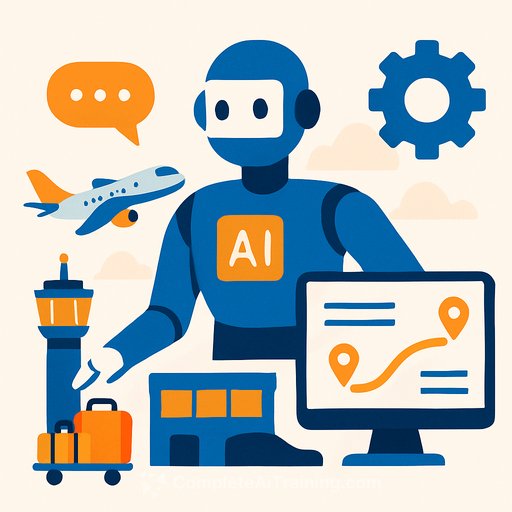Agentic AI: The Intelligence Layer That Orchestrates Airline Operations
Air travel is a web of systems, vendors, and handoffs. For years, digital efforts stalled at basic chat, self-service, or scripts. Agentic AI raises the bar. It doesn't just answer. It acts - across systems, with context, and without needing constant prompts.
No airline runs a fully agentic stack today. What we see are early wins: contact centers that resolve end-to-end, apps that proactively rebook, social channels that fix issues in-thread. Useful, but partial. Operations leaders should be aiming for a unified agentic layer that coordinates the entire journey and the enterprise behind it.
What Agentic AI Is - And Isn't
- Is: A network of specialized agents that share context, make decisions, and execute in sequence across multiple systems.
- Isn't: A single GPT-style chatbot hooked to a few APIs that answers questions or handles one narrow task at a time.
The difference is practical. A basic chatbot can tell a customer the flight is late. A coordinated agent network can rebook, update the gate with the airport, re-route baggage, notify catering, and apply loyalty compensation - automatically and in order.
Passenger-Facing Agents (B2C)
- Contact center agents: Go past scripts. Rebook, refund, process upgrades, and close cases without handoffs.
- Mobile/web assistants: Proactively suggest a later flight if a meeting overruns, reserve a lounge during a longer layover, or auto-issue boarding passes after an equipment swap.
- Social agents: Resolve disruptions where the passenger is complaining - rebook, compensate, or file mishandled baggage reports directly within the thread.
Early deployments are showing faster handle times, higher first-contact resolution, and improved loyalty metrics. The question isn't if this works - it's how fast you can scale it safely.
Operational and Collaborative Agents (B2B)
This is where the heavy lifting happens. Airlines, airports, ground handlers, and regulators still rely on decades-old formats and manual reconciliation. Type B messages, AIDX feeds, and email-faxed updates keep teams busy re-keying data instead of running the plan.
- Data normalization: Agents can ingest Type B and AIDX, cross-check with flight ops, and publish the single source of truth to all endpoints - apps, crew tablets, gate displays.
- Disruption control: Agents coordinate slot allocation, gate changes, crew updates, and rolling notifications in seconds, not hours.
- Baggage: With scan events, agents reconcile status under standard policies, message customers, and initiate compensation when criteria are met.
If you're advancing Airport Collaborative Decision-Making, anchor your agent strategy to it. See authoritative guidance on A-CDM from EUROCONTROL: Airport Collaborative Decision-Making (A-CDM). For data exchange, align to IATA's AIDX model: IATA AIDX.
Cross-Department Agents Inside the Airline
- Flight operations: Synchronize crew rosters, aircraft readiness, slots, and weather inputs. Push real-time plans to OCC, crew, and airport partners.
- MRO/Engineering: Monitor aircraft health, schedule maintenance, trigger parts delivery, and notify ops control of readiness risks automatically.
- Cargo: Optimize belly capacity by yield, prioritize high-value shipments, and coordinate with handlers to ensure accuracy at load time.
- Catering: Adjust meal counts and upgrades on the fly to cut waste while improving service.
- Crew housing and transport: Match rosters to rooms and buses in high-cost or congested stations with minimal manual planning.
- Corporate functions: Agents can onboard staff, validate crew training compliance, reconcile invoices, and track regulatory filings.
At the group level, agents can share parts across subsidiaries, re-allocate cargo capacity dynamically, and consolidate finance across jurisdictions - silent gains that improve resilience and cost.
A 24-Month Blueprint for Operations Leaders
Phase 1: Prove Value in Weeks
- Map top disruption flows (IRROPS, rebookings, gate changes, bag mishandling). Define success metrics and SLAs.
- Pick two high-friction use cases for pilots: missed connections recovery and proactive re-accommodation.
- Stand up a secure agent sandbox with read-only access first. Add write actions with approvals where risk is low.
Phase 2: Build the Integration Backbone
- Expose critical data via APIs or adapters for legacy (PNRs, inventory, ops control, crew, AIDX/Type B, baggage, loyalty).
- Adopt event-driven patterns. Agents should react to events (delay posted, gate swap, bag scan) and trigger sequenced actions.
- Implement policy guardrails: role-based access, separation of duties, audit trails, and human-in-the-loop for high-impact steps.
Phase 3: Scale Across Partners
- Align with airport A-CDM milestones and publish/subscribe to shared timelines.
- Standardize on AIDX for flight/gate data. Automate reconciliation of Type B while you phase it down.
- Run joint playbooks with key airports and ground handlers for IRROPS, including clear fallback to manual procedures.
Phase 4: Industrialize
- Vendor due diligence: insist on multi-agent orchestration, deterministic tools where precision is required, and strong observability.
- Model risk management: test data drift, prompt injection defenses, and rollback plans. Keep PII and payment data segmented.
- Measure relentlessly: time-to-resolution, recovered connections, on-time pushback, bag delivery rate, CSAT/NPS, cost per handled disruption.
How To Spot "Agentic-In-Name-Only"
- Can it coordinate across multiple systems in a single flow without human prompts at every step?
- Does it maintain shared context across agents and channels (contact center, app, social)?
- Are actions sequenced with dependency checks (e.g., seat confirmed before bag re-route, before catering update)?
- Is there full auditability and policy enforcement for every action?
Risk, Compliance, and Change
- Safety and compliance: Guardrails for operational actions, mandatory approvals for high-impact changes, immutable logs for regulators.
- Data privacy: Minimize PII, encrypt at rest/in transit, align with local regulations.
- Resilience: Clear failover to manual, incident response runbooks, and simulated drills.
- People: Train agents as copilots for staff - not replacements. Update SOPs, incentives, and quality reviews.
What Good Looks Like
- IRROPS recovery measured in minutes, not hours.
- Fewer missed connections; higher same-day recovery rate.
- Improved on-time departures through tighter gate/slot/crew sync.
- Higher bag delivery accuracy and faster notification when issues occur.
- Lower cost-to-serve per disruption and higher CSAT/NPS.
The Big Picture
Agentic AI is the coordination fabric airlines have been missing. Passenger-facing agents create visible gains. Operational agents deliver the resilience that keeps the network moving. Cross-department agents tie it all together.
The carriers that standardize data, integrate with airport partners, and enforce strong governance will set the pace. Everyone else will be stuck stitching messages and firefighting.
Upskill Your Ops Team
If you're formalizing an agentic roadmap and need practical training for operations leaders and teams, explore curated AI courses by job role: Complete AI Training - Courses by Job.
Your membership also unlocks:






